21 个稳定版本
| 3.1.2 | 2023 年 7 月 2 日 |
|---|---|
| 3.1.1 | 2023 年 7 月 1 日 |
| 3.0.2 | 2023 年 6 月 12 日 |
| 3.0.1 | 2023 年 5 月 29 日 |
| 1.1.0 | 2023 年 2 月 15 日 |
114 在 文件系统 中排名 #114
173 每月下载量
225KB
4.5K SLoC
erdtree (erd)
erdtree 是一个现代、跨平台、多线程的通用文件系统和磁盘使用工具,它能够识别 .gitignore 和隐藏文件规则。以下是一些特性亮点:
- 使用多种指标报告磁盘使用情况:字节(逻辑或物理)、块(仅限 Unix)、单词计数或行计数。
- 支持类似
ls -l的视图,包含所有者、组、文件权限等信息(仅限 Unix)。 - 默认遵守隐藏文件和 gitignore 规则。
- 支持基于正则表达式和 glob 的按文件类型搜索。
- 提供多种布局:反转树输出、类似
tree的输出或类似du的输出。 - 细粒度排序能力。
- 支持图标。
- 使用
LS_COLORS着色。
您可以将 erdtree 视为 du、tree、find、wc 和 ls 的一点点结合。

目录内容
用法
$ erd --help
erdtree (erd) is a cross-platform, multi-threaded, and general purpose filesystem and disk usage utility.
Usage: erd [OPTIONS] [DIR]
Arguments:
[DIR]
Directory to traverse; defaults to current working directory
Options:
-c, --config <CONFIG>
Use configuration of named table rather than the top-level table in .erdtree.toml
-C, --color <COLOR>
Mode of coloring output
[default: auto]
Possible values:
- none: Print plainly without ANSI escapes
- auto: Attempt to colorize output
- force: Turn on colorization always
-d, --disk-usage <DISK_USAGE>
Print physical or logical file size
[default: physical]
Possible values:
- logical:
How many bytes does a file contain
- physical:
How many actual bytes on disk, taking into account blocks, sparse files, and compression
- line:
How many total lines a file contains
- word:
How many total words a file contains
- block:
How many blocks are allocated to store the file
-f, --follow
Follow symlinks
-H, --human
Print disk usage in human-readable format
-i, --no-ignore
Do not respect .gitignore files
-I, --icons
Display file icons
-l, --long
Show extended metadata and attributes
--group
Show file's groups
--ino
Show each file's ino
--nlink
Show the total number of hardlinks to the underlying inode
--octal
Show permissions in numeric octal format instead of symbolic
--time <TIME>
Which kind of timestamp to use; modified by default
Possible values:
- create: Time created (alias: ctime)
- access: Time last accessed (alias: atime)
- mod: Time last modified (alias: mtime)
--time-format <TIME_FORMAT>
Which format to use for the timestamp; default by default
Possible values:
- iso:
Timestamp formatted following the iso8601, with slight differences and the time-zone omitted
- iso-strict:
Timestamp formatted following the exact iso8601 specifications
- short:
Timestamp only shows date without time in YYYY-MM-DD format
- default:
Timestamp is shown in DD MMM HH:MM format
-L, --level <NUM>
Maximum depth to display
-p, --pattern <PATTERN>
Regular expression (or glob if '--glob' or '--iglob' is used) used to match files
--glob
Enables glob based searching
--iglob
Enables case-insensitive glob based searching
-t, --file-type <FILE_TYPE>
Restrict regex or glob search to a particular file-type
Possible values:
- file: A regular file
- dir: A directory
- link: A symlink
-P, --prune
Remove empty directories from output
-s, --sort <SORT>
How to sort entries
[default: size]
Possible values:
- name: Sort entries by file name in lexicographical order
- rname: Sort entries by file name in reversed lexicographical order
- size: Sort entries by size smallest to largest, top to bottom
- rsize: Sort entries by size largest to smallest, bottom to top
- access: Sort entries by newer to older Accessing Date
- raccess: Sort entries by older to newer Accessing Date
- create: Sort entries by newer to older Creation Date
- rcreate: Sort entries by older to newer Creation Date
- mod: Sort entries by newer to older Alteration Date
- rmod: Sort entries by older to newer Alteration Date
--dir-order <DIR_ORDER>
Sort directories before or after all other file types
[default: none]
Possible values:
- none: Directories are ordered as if they were regular nodes
- first: Sort directories above files
- last: Sort directories below files
-T, --threads <THREADS>
Number of threads to use
[default: 10]
-u, --unit <UNIT>
Report disk usage in binary or SI units
[default: bin]
Possible values:
- bin: Displays disk usage using binary prefixes
- si: Displays disk usage using SI prefixes
-x, --one-file-system
Prevent traversal into directories that are on different filesystems
-y, --layout <LAYOUT>
Which kind of layout to use when rendering the output
[default: regular]
Possible values:
- regular: Outputs the tree with the root node at the bottom of the output
- inverted: Outputs the tree with the root node at the top of the output
- flat: Outputs a flat layout using paths rather than an ASCII tree
- iflat: Outputs an inverted flat layout with the root at the top of the output
-., --hidden
Show hidden files
--no-git
Disable traversal of .git directory when traversing hidden files
--completions <COMPLETIONS>
Print completions for a given shell to stdout
[possible values: bash, elvish, fish, powershell, zsh]
--dirs-only
Only print directories
--no-config
Don't read configuration file
--no-progress
Hides the progress indicator
--suppress-size
Omit disk usage from output
--truncate
Truncate output to fit terminal emulator window
-h, --help
Print help (see a summary with '-h')
-V, --version
Print version
-l, --long 以及所有相关参数目前在 Windows 上不可用,但计划支持 Windows 版本。
安装
crates.io (非 Windows)
请确保您已安装 Rust 及其工具链。
$ cargo install erdtree
crates.io (Windows)
Windows 版本依赖于一些实验性功能以正确支持硬链接检测。如果您想从 crates.io 构建的话,您需要先安装 nightly 工具链,然后再安装 erdtree。
$ rustup toolchain install nightly-2023-06-11
之后
$ cargo +nightly-2023-06-11 install erdtree
Homebrew-core
$ brew install erdtree
Scoop
$ scoop install erdtree
NetBSD
$ pkgin install erdtree
版本发布
可以从最新版本中下载适用于常见架构的二进制文件。
最新非发布版本
如果您想使用 master 上的最新功能,但这些功能尚未作为版本的一部分包含在内
$ cargo install --git https://github.com/solidiquis/erdtree --branch master
其他安装方式即将推出。
文档
配置文件
如果 erdtree 的默认设置不符合您特定的要求,您可以使用配置文件设置自己的默认设置。
配置文件目前有两种格式:.erdtreerc(即将弃用)和 .erdtree.toml。如果您两者都有,.erdtreerc 将优先考虑,而 .erdtree.toml 将被忽略,但请注意 .erdtreerc 将在不久的将来被弃用。没有必要两者都保留。
TOML 文件
erdtree 将在以下位置之一查找 .erdtree.toml
在 Unix 系统
$ERDTREE_TOML_PATH
$XDG_CONFIG_HOME/erdtree/.erdtree.toml
$XDG_CONFIG_HOME/.erdtree.toml
$HOME/.config/erdtree/.erdtree.toml
$HOME/.erdtree.toml
在 Windows
%APPDATA%\erdtree\.erdtree.toml
这里 以及以下是一个有效的 .erdtree.toml 示例
icons = true
human = true
# Compute file sizes like `du`
# e.g. `erd --config du`
[du]
disk_usage = "block"
icons = true
layout = "flat"
no-ignore = true
no-git = true
hidden = true
level = 1
# Do as `ls -l`
# e.g. `erd --config ls`
[ls]
icons = true
human = true
level = 1
suppress-size = true
long = true
# How many lines of Rust are in this code base?
# e.g. `erd --config rs`
[rs]
disk-usage = "line"
level = 1
pattern = "\\.rs$"
.erdtree.toml 支持多个配置。顶层表是主配置,将不添加额外参数而应用。如果您想使用单独的配置,创建一个命名表,如上例中的 du,设置您的参数,并按如下方式调用它
$ erd --config du
# equivalent to
$ erd --disk-usage block --icons --layout flat --no-ignore --no-git --hidden --level 1
关于参数,您需要了解以下三条规则
.erdtree.toml只接受带前缀的短名称参数。- 类型被强制执行,所以数字应该是数字,布尔值应该是布尔值,字符串应该是字符串,依此类推。
snake_case和kebap-case都有效。
.erdtreerc
erdtree 将在以下位置之一查找配置文件
在 Linux/Mac/Unix-like
$ERDTREE_CONFIG_PATH$XDG_CONFIG_HOME/erdtree/.erdtreerc$XDG_CONFIG_HOME/.erdtreerc$HOME/.config/erdtree/.erdtreerc$HOME/.erdtreerc
在 Windows
$ERDTREE_CONFIG_PATH%APPDATA%\erdtree\.erdtreerc
配置文件的格式如下
- 每一行都是一个
erdtree选项/参数。 - 以
#开头的行被视为注释,因此会被忽略。
命令行中传递给 erdtree 的参数将覆盖 .erdtreerc 中的参数。
点击这里 查看一个 .erdtreerc 示例。
如果您想忽略某个配置而不删除它,可以使用 --no-config。
硬链接
如果在同一文件树中有多个指向同一inode的硬链接,它们都将包含在输出中,但在计算总磁盘使用量时只考虑一个。
符号链接
-f, --follow
Follow symlinks
当跟随符号链接时,其目标(及其子代)将被计入总磁盘使用量,否则将报告符号链接本身的大小。如果符号链接的目标恰好与符号链接本身位于同一文件树中,则目标及其子代不会被重复计入总磁盘使用量。当跟随目录符号链接时,其子代的所有框绘制字符将以不同的颜色绘制,以提供更好的视觉反馈。
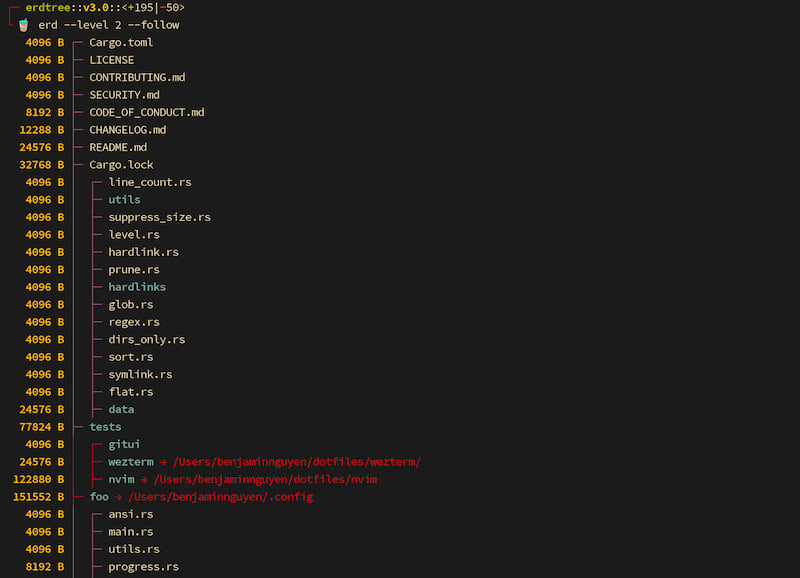
磁盘使用
默认情况下,磁盘使用量报告为存储在磁盘上的物理字节数量。要获取可读形式
-H, --human
Print disk usage in human-readable format
当使用可读形式时,默认情况下会报告二进制单位(例如 1 KiB = 1024 B)。如果您更喜欢SI单位(1 KB = 1000 B),可以使用以下命令
-u, --unit <UNIT>
Report disk usage in binary or SI units
[default: bin]
Possible values:
- bin: Displays disk usage using binary prefixes
- si: Displays disk usage using SI prefixes
此外,可以使用各种其他磁盘使用量指标代替物理字节数。您有以下指标可供选择
-d, --disk-usage <DISK_USAGE>
Print physical or logical file size
[default: physical]
Possible values:
- logical:
How many bytes does a file contain
- physical:
How many actual bytes on disk, taking into account blocks, sparse files, and compression
- line:
How many total lines a file contains
- word:
How many total words a file contains
- block:
How many blocks are allocated to store the file
最后,如果您想从输出中省略磁盘使用量
--suppress-size
Omit disk usage from output
物理与逻辑
实际大小考虑了压缩、稀疏文件和分配给特定文件的实际块。逻辑大小仅报告文件中的总字节数。
匹配 du 输出
如果您想得到与 du 相同的磁盘使用量报告,可以这样做
$ erd --layout flat --disk-usage block --no-ignore --hidden --level
或简写为
$ erd -y flat -d block -i -.
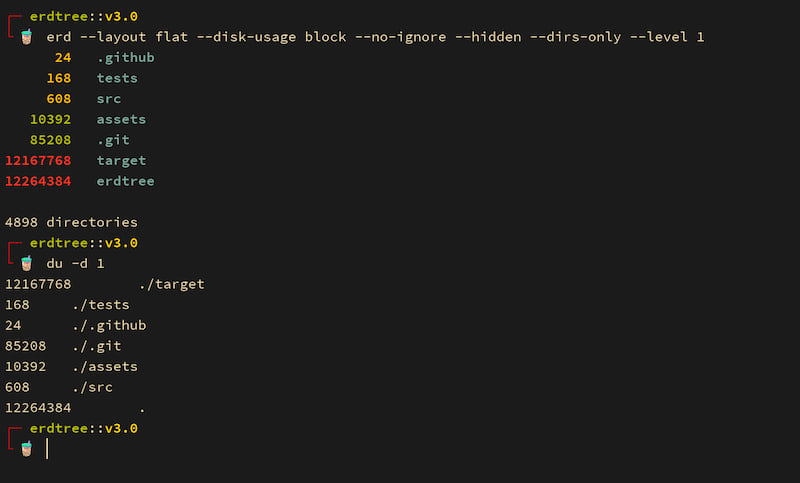
单词和行计数
当选择以单词和行数报告磁盘使用量时,与 wc 不同,erdtree 不会尝试计算无法编码为UTF-8字符串的文件(如JPEG文件)的单词或行数。对于这些情况,行或总单词数将仅显示为空。
此外,目录的单词和行数是其所有子代的行/单词数的总和。
布局
erdtree 提供了四种布局
-y, --layout <LAYOUT>
Which kind of layout to use when rendering the output
[default: regular]
Possible values:
- regular: Outputs the tree with the root node at the bottom of the output
- inverted: Outputs the tree with the root node at the top of the output
- flat: Outputs a flat layout using paths rather than an ASCII tree
- iflat: Outputs an inverted flat layout with the root at the top of the output
inverted布局是一种更传统的类似tree的布局,其中根节点位于输出的最顶部。regular布局是一种树形结构,根节点位于输出的底部,可以快速了解总磁盘使用量。flat布局是一种无树的输出,更类似于du。
gitignore
-i, --no-ignore
Do not respect .gitignore files
.gitignore 默认受尊重,但可以使用上述参数忽略。每个目录的 .gitignore 规则也受尊重,因此每个在遍历时遇到的具有 .gitignore 的目录也将被考虑。
如果尊重 .gitignore,则忽略的任何文件将不会包括在总磁盘使用量中。
隐藏文件
-., --hidden
Show hidden files
--no-git
Disable traversal of .git directory when traversing hidden files
隐藏文件默认被忽略,但可以使用 -., --hidden 包括。如果选择显示隐藏文件,则包括 .git;要排除它,请使用 --no-git。
如果忽略隐藏文件,则它不会包括在总磁盘使用量中。
图标
-I, --icons Display file icons
图标是可选功能,因为为了正确渲染图标,您连接到终端模拟器的字体必须包含必要的符号。
如果您的图标看起来像这样
![]()
这意味着您使用的字体不包含相关的符号。要解决这个问题,请下载一个 NerdFont 并将其连接到您的终端模拟器。
最大深度
默认情况下,将完全遍历目录。要限制最大深度
-L, --level <NUM>
Maximum depth to display
限制要显示的最大深度不会影响总磁盘使用量报告或文件计数报告。
修剪空目录
有时输出中可能会出现空目录。要删除它们
-P, --prune
Remove empty directories from output
排序
提供了各种排序方法
-s, --sort <SORT>
How to sort entries
[default: size]
Possible values:
- name: Sort entries by file name in lexicographical order
- rname: Sort entries by file name in reversed lexicographical order
- size: Sort entries by size smallest to largest, top to bottom
- rsize: Sort entries by size largest to smallest, bottom to top
- access: Sort entries by newer to older Accessing Date
- raccess: Sort entries by older to newer Accessing Date
- create: Sort entries by newer to older Creation Date
- rcreate: Sort entries by older to newer Creation Date
- mod: Sort entries by newer to older Alteration Date
- rmod: Sort entries by older to newer Alteration Date
--dir-order <DIR_ORDER>
Sort directories before or after all other file types
[default: none]
Possible values:
- none: Directories are ordered as if they were regular nodes
- first: Sort directories above files
- last: Sort directories below files
--dir-order 和 --sort 可以独立使用。
仅目录
您只能输出具有
--dirs-only
Only print directories
这不会影响总磁盘使用量。
长视图
目前仅在类Unix平台上可用。计划支持Windows。
erdtree 支持类似于 ls -l 的长视图
-l, --long
Show extended metadata and attributes
--group
Show file's groups
--ino
Show each file's ino
--nlink
Show the total number of hardlinks to the underlying inode
--octal
Show permissions in numeric octal format instead of symbolic
--time <TIME>
Which kind of timestamp to use; modified by default
Possible values:
- create: Time created (alias: ctime)
- access: Time last accessed (alias: atime)
- mod: Time last modified (alias: mtime)
--time-format <TIME_FORMAT>
Which format to use for the timestamp; default by default
Possible values:
- iso:
Timestamp formatted following the iso8601, with slight differences and the time-zone omitted
- iso-strict:
Timestamp formatted following the exact iso8601 specifications
- short:
Timestamp only shows date without time in YYYY-MM-DD format
- default:
Timestamp is shown in DD MMM HH:MM format
默认情况下,显示的列从左到右的顺序是
- 权限 以符号表示法
- 文件所有者
- 文件最后修改日期(或创建日期或最后访问日期)
正则表达式和 globbing
使用以下方式支持通过正则表达式或通配符过滤特定文件
-p, --pattern <PATTERN>
Regular expression (or glob if '--glob' or '--iglob' is used) used to match files
--glob
Enables glob based searching
--iglob
Enables case-insensitive glob based searching
-t, --file-type <FILE_TYPE>
Restrict regex or glob search to a particular file-type
Possible values:
- file: A regular file
- dir: A directory
- link: A symlink
如果在过滤时未提供 --file-type,则默认为常规文件(file)。
此外,任何被过滤掉的文件将不会计入总磁盘使用量。
最后,当将正则表达式或通配符应用于目录时,无论文件类型如何,其所有后代都会包含在输出中。如果您只想显示目录,可以使用 --dirs-only。
参考
截断输出
在输出不适合终端模拟器窗口的情况下,输出本身可能会变得不连贯
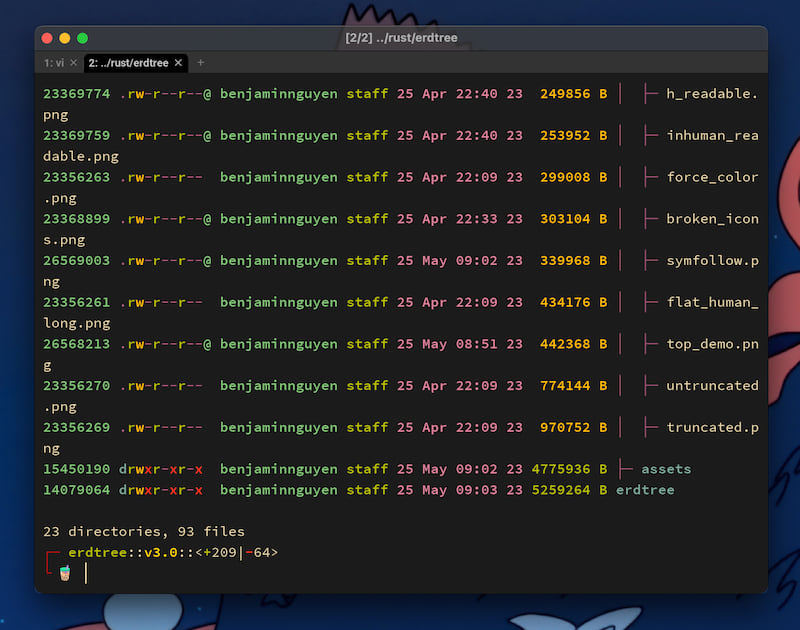
在这种情况下,可以使用以下方法
--truncate
Truncate output to fit terminal emulator window
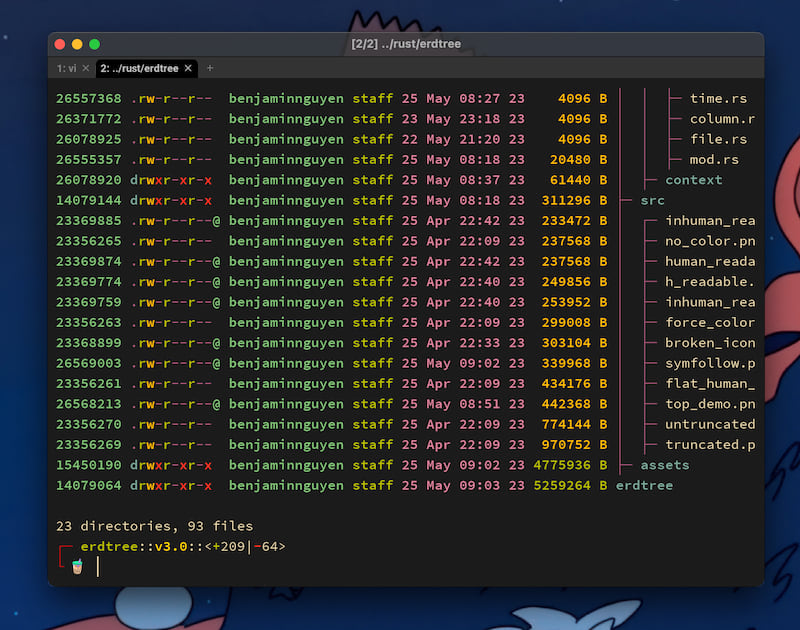
重定向输出和着色
默认情况下,如果发现 stdout 是一个 tty,则启用输出着色。如果输出不是一个 tty,例如将输出重定向到文件或将输出管道传输到另一个命令,则禁用着色。
然而,如果默认行为不适合您的需求,您可以控制着色的模式
-C, --color <COLOR>
Mode of coloring output
[default: auto]
Possible values:
- none: Print plainly without ANSI escapes
- auto: Attempt to colorize output
- force: Turn on colorization always
erdtree 还支持 NO_COLOR。
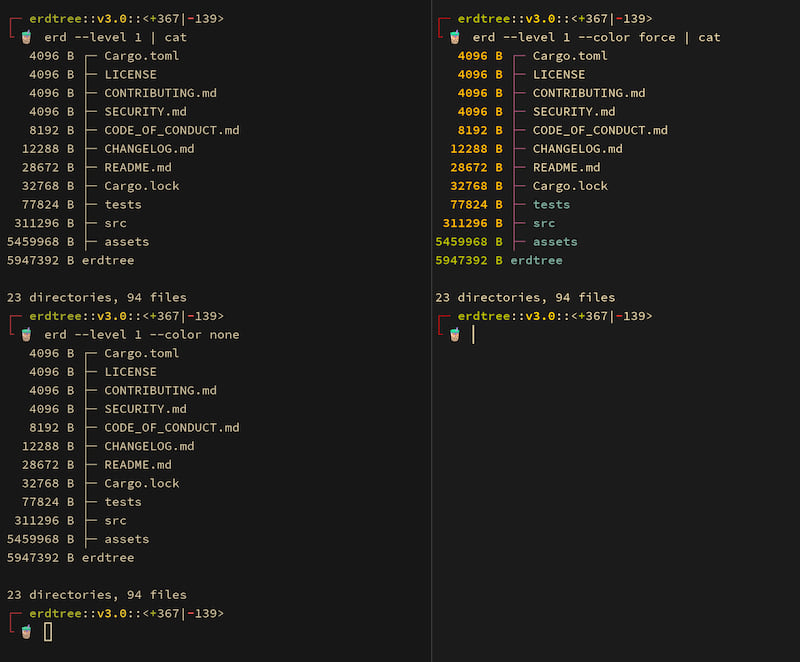
并行处理
可以通过以下方式调整 erdtree 使用的线程数
-T, --threads <THREADS> Number of threads to use [default: 3]
为什么需要并行处理
人们常常问的一个问题是,当文件系统I/O以串行方式处理时,并行处理是如何在磁盘读取中受益的。
虽然这是真的,但并行处理仍然由于磁盘有一个 队列深度,当饱和时,允许请求以聚合方式处理,从而使磁盘保持忙碌,而不是等待 erdtree 在请求之间进行CPU密集型处理。此外,这些线程不仅仅并行处理磁盘读取,还并行处理检索到的数据。
然而,需要注意的是,性能作为线程数的一个函数,其性质是渐近的(参见 Amdahl定律),因此您会在达到一定线程数阈值后迅速达到收益递减的点,因为您会为管理更大的线程池付出代价,而没有任何额外的收益。
关于该主题的实证数据,请参阅 这篇文章。
补全
--completions 用于为常用shell生成自动补全,以便 tab 键可以尝试完成您的命令或提供提示;您放置输出的位置高度依赖于您的shell以及您的配置。在我的环境中,我使用 zshell 与 oh-my-zsh,我会这样安装补全
$ et --completions zsh > ~/.oh-my-zsh/completions/_erd
$ source ~/.zshrc
相同文件系统
如果你正在遍历包含其他文件系统挂载点的目录,而这些挂载点是你不想遍历的,请使用以下方法
-x, --one-file-system
Prevent traversal into directories that are on different filesystems
贡献规则
有关如何贡献的规则,请参阅CONTRIBUTING.md。
安全策略
有关erdtree的安全策略以及如何报告安全漏洞的信息,请参阅SECURITY_POLICY.md。
与类似程序的比较
以下程序本身都非常出色,并且在erdtree的开发中产生了深远的影响。虽然以下每个程序都高度专业化,作为Unix前辈的现代替代品,但erdtree的目标是收集人们最常使用的一些功能,将它们组装成一个统一且高度实用的工具。
这里不会详细说明为什么erdtree比X、Y或Z更好,但由于它与以下程序有一些显著相似之处,因此值得简要比较。
exa
exa和erdtree都相似,因为它们都提供树状视图,并显示有关权限、所有者、组等信息。
然而,exa的缺点是它不提供有关目录磁盘使用情况的信息,这也使得按大小排序文件有些令人怀疑。但是,exa与erdtree相比的优势在于,exa作为一个ls替代品更为全面。
这两个工具是互补的,建议您将它们都纳入您的工具箱。
dua
dua是一款出色的交互式磁盘使用工具,是ncdu的现代替代品。如果您想要一个交互式且仅关注磁盘使用的工具,那么dua可能更适合您。如果您对文件权限感兴趣,并想在不启动整个交互式UI的情况下快速进行磁盘使用静态分析,那么可能需要考虑使用erdtree。
dust
dust是另一款出色的工具,它在血统上更接近传统的du命令。如果您严格寻找du的现代替代品,那么dust是一个不错的选择。
fd
fd作为一个通用的查找工具更为全面,它本身可以作为一个现代的find替代品。如果您在搜索时需要更多的粒度,而不仅仅是globbing、正则表达式以及三种基本文件类型(文件、目录和符号链接),那么fd是最佳选择。
你可能有的问题
问:你为什么要做这个?这完全是多余的。
答:无聊。
问:为什么叫erdtree?
答:这是对《艾尔登法环》中一个崇拜对象的引用。
问:它好吗?
答:是的。
问:为什么没有提到这个项目速度极快或用Rust编写的?是不是很慢?
答:好吧,好吧。 erdtree是用Rust编写的,速度极快。

依赖项
~10–23MB
~287K SLoC